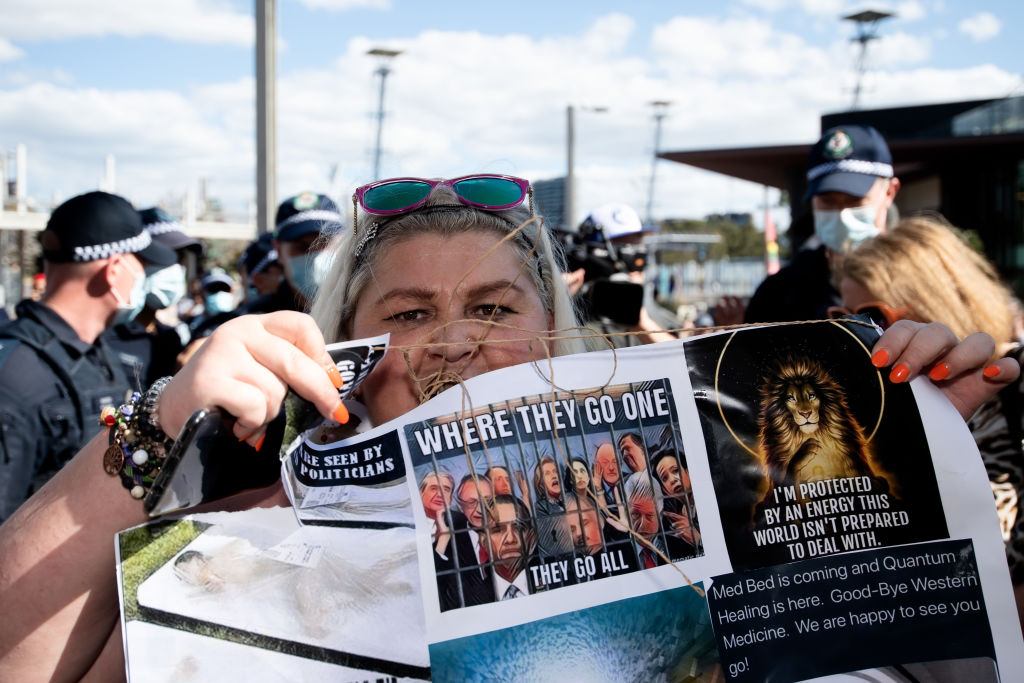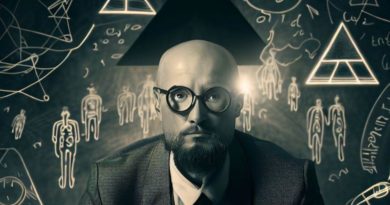The U.S. Exported QAnon to Australia and New Zealand. Now It’s Creeping Into COVID-19 Lockdown Protests
Like most people, Jess spent a lot of time online during weeks of lockdown earlier this year. But the 36-year-old Australian wasn’t focused so much on playing Animal Crossing or watching Netflix. Instead, she found herself diving ever deeper into the Internet for information about QAnon.
Jess, who asked for her last name not to be used because her employer doesn’t allow her to share views on social media, says she became interested in the complex conspiracy theory in part because it claims to offer answers amid the turbulence of 2020.
She says she’s not always sure she believes everything she reads about QAnon online. But she has become active in the QAnon community on Twitter, tweeting out a mix of claims about secret pedophilia rings, anti-Joe Biden articles and pro-Trump content several times a day. “It seems to have really started picking up here. I think, because things are picking up so much over there in America,” Jess tells TIME from her Sydney home. “A lot of the stuff I read and see is shared by people in the U.S.”

Jess, a mother from Sydney, Australia, says she became interested in QAnon during weeks of lockdown. She now tweets claims about secret pedophilia rings, anti-Joe Biden articles and pro-Trump content multiple times a day.
For a conspiracy theory with origins in American politics, QAnon is proving remarkably malleable for export outside the U.S., fueled by growing frustration over COVID-19 restrictions around the world. In Australia and New Zealand, especially, it has taken on a life of its own—with followers adapting QAnon to incorporate local politicians and causes.
As in the United States, QAnon in Australia and New Zealand has mixed with other global conspiracy theories, including false beliefs that 5G towers are spreading coronavirus, unfounded claims that COVID-19 was either pre-planned or is a hoax and baseless theories about public vaccination programs. That turgid brew of misinformation is increasingly moving offline and spilling over into the streets in the form of protests or sometimes aggressive refusals to follow social distancing restrictions.
“We have seen the emergence of transnational, amorphous conspiracy-theory based movements,” says Joshua Roose, a senior research fellow at Deakin University in Australia. “All share a strong distrust in government and state institutions.”
QAnon began in 2017 as a uniquely American conspiracy theory. Followers of the movement, which has moved from far-right Internet forums onto mainstream social media sites, believe that President Donald Trump is fighting against a shadowy secret society that runs the world. Supporters claim this elite cabal is comprised of Democratic politicians, Satan-worshipping pedophiles and Hollywood celebrities who run a global child sex-trafficking ring, harvesting the blood of children for life-sustaining chemicals. None of this has any basis in fact.
QAnon spills over into the streets
The local strain of QAnon appears to be spurred by anger at COVID-19 restrictions: A resurgence of COVID in July forced the Australian state of Victoria—where Melbourne is located—into one of the most restrictive lockdowns in the world for weeks. In New Zealand, a small coronavirus outbreak in August also forced the government to reimpose restrictions in Auckland, the largest city.
Lockdown measures have eased in both countries, but supporters of QAnon continue to spread their conspiracy theories online—and, increasingly, offline. QAnon signs cropped up at “Freedom Day” anti-lockdown protests across Australia on Sept. 5, as well as at similar protests in Auckland.

A protester holds a sign up during the Freedom Day Rally in Sydney on Sept. 5, 2020.
Speed Media/Icon Sportswire/Getty Images
At checkpoints set up to ensure citizens are following COVID-19 movement restrictions in the state of Victoria in August, police were forced to smash several peoples’ car windows and drag them out for refusing to provide personal details because they claimed to be “sovereign citizens”.
The fringe movement started in the United States in the 1970s, with followers believing that ultimate power is vested in individuals, who are therefore not obligated to obey government rules they disagree with, whether that be motor vehicle regulations, answering to the police or paying taxes. Videos of the Victoria arrests have been widely shared on social media accounts that also spread QAnon theories—further fueling anger over COVID-19 restrictions.
Read more: The Misinformation Age Has Exacerbated—And Been Exacerbated By—the Coronavirus Pandemic
A local twist on a conspiracy theory
QAnon may center around an American conspiracy theory, but that hasn’t stopped supporters in Australia and New Zealand from adding their own local flavors.
One twist involves the hundred miles of storm drain tunnels running beneath Melbourne. Some Australian QAnon posts claim that Melbourne’s coronavirus lockdown was meant to keep the streets clear for an operation to rescue child sex-trafficking victims in the tunnels. (There is no evidence of this.)
The conspiracy theory also predicts the arrest of high-level officials for sex trafficking crimes. Again, resourceful Australian QAnon followers have adapted that narrative for their home turf. One Facebook post seen by TIME (falsely) alleged that Australia’s Prime Minister Scott Morrison has been under house arrest since January. The evidence? Blurry, close-up photos of Morrison wearing long pants, which appear to have either bunched up or been folded at the ankle and supposedly prove the Australian leader is wearing an ankle monitor.
Similar (false) rumors have also circulated using pictures that show Victoria Premier Dan Andrews walking down the street. Andrews, who has faced heavy criticism from the right for weeks-long coronavirus lockdowns this summer, features heavily in posts on QAnon-affiliated pages.
At a rally in New Zealand in early September, protesters referenced multiple COVID-19 conspiracy theories, according to local reports. But demonstrators have also woven in local causes. Some protesters were seen holding signs calling to “ban 1080,” a reference to the government’s use of poison to control populations of invasive rodents (the cause has been supported by some mainstream groups in recent years, but has been fodder for conspiracy theorists.) At least one protester was spotted with a sign that depicted Prime Minister Jacinda Ardern as Adolf Hitler.
One social media post in May claimed that Bill Gates was in New Zealand and asserted that the country of 5 million is a “perfect” nation “to test and trial” a vaccine for the coronavirus. (A spokesperson for the Bill & Melinda Gates Foundation said Gates had not been in New Zealand.)
And combining QAnon’s American roots with local feelings often meshes in inconsistent ways. For example, many Australian QAnon-affiliated accounts are highly critical of Australian police, who have used tough responses to enforce COVID-19 restrictions. Those posts are often shared alongside rightwing U.S. media articles praising American officers.
Read More: Here’s Why Experts Worry About the Popularity of QAnon’s Conspiracy Theory
Social media companies respond
Despite its presence at protests, QAnon really thrives online, and it gained a substantial foothold in Australia and New Zealand during COVID-19 lockdowns. One Facebook group started in Australia, comprising a mix of people denying the existence of the coronavirus, anti-vaxxers, so-called sovereign citizens and QAnon supporters, had more than 65,000 members before it was removed by the social media giant.
“You put marginalized people under pressure and fear and they look for non-mainstream and unorthodox theories to regain their sense of control and agency,” says Michael Grimshaw, of the University of Canterbury in New Zealand.
The conspiracy theories—and opposition to coronavirus restrictions in general—remain at the fringes in both nations. A recent Pew poll shows that 94% of Australians think the country did a good job handling the pandemic (the same poll reported that only 47% of Americans felt the same way). An August poll found that public confidence in health officials in New Zealand was above 80%.
But misinformation is increasingly bleeding over into the mainstream. Australian television chef Pete Evans—who has 275,000 Instagram followers—has posted QAnon-related content on Instagram in recent months. In New Zealand, a lifestyle influencer with more than 60,000 followers posted in support of QAnon claims in her Instagram story. “There’s soooooo much I want and need to address on here. But I’m going to start slowly and it will start with Hollywood, Cabal and Human Trafficking,” she said in one Instagram story. “People may think why? That’s America it has nothing to do with us. In the big scheme of things it has EVERYTHING to do with us. All you need to do is research Jacinda Ardern and her ties with Bill Gates…”
Both Facebook and Twitter say they’re taking action against QAnon-related content. Twitter announced in late July a stronger approach to dealing with QAnon, including permanently suspending accounts that violate its policies, banning URLs associated with QAnon from being shared on the site, limiting content from its trends and recommendations and not highlighting it in searches.
Facebook said in August it had removed 790 groups, 100 pages and 1,500 ads tied to QAnon and other groups it said support violence and blocked more than 300 hashtags across Facebook and Instagram worldwide. The company says that QAnon pages, groups and accounts will be removed when they violate Facebook’s community standards, including inciting violence. The company also said it will limit some content from recommendations and the ranking of this content will be lower in News Feed.
Despite their efforts to reduce the accessibility of QAnon content, a quick search shows Australia and New Zealand-specific QAnon conspiracy theories are widely available on both platforms. TIME found at least three separate Twitter accounts, with thousands of followers each, that used Australian QAnon hashtags in their profiles. TIME also found public Facebook groups specific to Australia and New Zealand that hosted QAnon posts, each with hundreds of members.
Three Facebook groups with QAnon-related posts that TIME asked the company about remain public. Facebook said that one post alleging the Australian Prime Minister is under house arrest would be removed when TIME inquired about it. But days later the post was still available on the platform. Facebook said this was due to a technical glitch on their end. However, at least one other post on the group also made the same false allegation about the Prime Minister.
One Australia-focused QAnon account with more than 4,000 followers was removed by Twitter for “multiple account violations” after TIME inquired about it.
Entering the mainstream
Increasingly, ordinary Internet users are spreading QAnon-related memes and theories. Lydia Khalil, a research fellow at the Sydney-based think-tank the Lowy Institute, says some conspiracy theories have spread via mommy blogs, and fitness and wellness influencers, who have latched on to the child-sex trafficking and anti-vaccine elements of these theories.
“Not all of the people spreading this stuff are hard-core conspiracy theorists or extremists, they’re picking up on hashtags or more nebulous elements of this and then pushing it out without really understanding who’s behind it and where it’s coming from,” she says.
But leaders in Australia and New Zealand have been forced to publicly address some of the conspiracy theories because they became so prevalent. Australian officials have been forced to publicly refute the link between 5G and coronavirus, and on a television program on Aug. 5, Prime Minister Scott Morrison told people identifying as “sovereign citizens” and anti-maskers intentionally defying coronavirus restrictions to “get real.”
New Zealand’s health minister asked the public at a Sept. 10 COVID-19 briefing to “think twice before sharing information that can’t be verified.”

Many protesters blame 5G technology for the Coronavirus during the Coronavirus (COVID-19) Anti-Lockdown Protest at Parliament House in Melbourne on May 10, 2020.
Speed Media/Icon Sportswire/Getty Images
Matthew Schlapfer, a business consultant who lives in the Australian city of Perth, says he’s unfriended or been unfriended by about 10 people in recent months as he got fed up with seeing conspiracy theories filling his Facebook feed.
“I started getting really annoyed and reaching out and saying ‘where are you getting your information from?’” he says. “I would ask ‘what’s the source for this?’” and they couldn’t tell me.
Schalpfer, who is in his mid-forties, says many of the posts that started the disagreements were related to QAnon. Others argued against the use of vaccines, or falsely proclaimed that COVID is a hoax. Some of his former friends—including two ex-girlfriends, three former colleagues and several high school acquaintances—have posted messages supporting Trump.
“They have fully bought into this Trump saving us from the deep state and this global child pedophilia ring run by the liberal elites thing,” Schlapfer says.
SHARE THIS STORY
*** This article has been archived for your research. The original version from TIME can be found here ***




